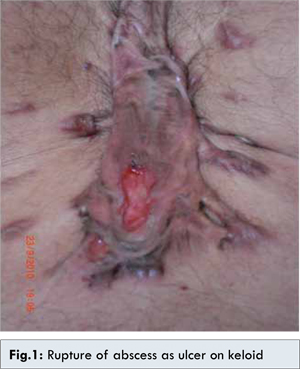6go6ckt5b8|3000F7576AC3|Tab_Articles|Fulltext|0xf1fff48e03000000f601000001000f00
6go6ckt5b5idvals|220
6go6ckt5b5idcol1|ID
6go6ckt5b5|2000F757Tab_Articles|Fulltext
Introduction
Cutaneous tuberculosis was first documented in 1826, when Laennec reported his own “Prosector’s wart” [
1]. Cutaneous tuberculosis accounts for only less than 1-2 % of cases of tuberculosis [
2]. The factors influencing the presentation of cutaneous tuberculosis are host’s immune status, presence or absence of host sensitization to Mycobacterium tuberculosis and the pathway of bacterial entry into skin. The infection is usually acquired exogenously and hence the lesions are on exposed trauma prone areas [
3]. The lesions show a wide spectrum of morphology and require the correlation of clinical findings with diagnostic tests [
4]. There are reports on mycobacterial infection of keloid presenting as ulcerative forms [
5-
7]. Here, we are reporting a rare case of cutaneous tuberculosis developing over a keloid as cold abscess.
Case Report
A 72 year old male patient presented with a fluctuating area on the lowest part of keloid on sternum. This was accompanied by evening rise of body temperature with extreme weakness and loss of appetite for last eight months. Social history revealed one of his tenants was on antitubercular therapy. Patient had coronary artery bypass surgery 6 year back. There was no sign of inflammation and lesion ruptured on palpation leaving behind an ulcer with ragged and undermined margin [Fig.1]. The pus was collected in a sterile container immediately and sent for bacteriological examination. He gave the history of five intralesional triamcinolone injections at monthly interval 1 year back.

Bacteriological examination of pus revealed gram negative bacilli in gram stain and acid fast bacilli in Ziehl-Neelsen (Z-N) stain [Fig.2]. There was no evidence of pulmonary tuberculosis and involvement of underlying tissues or lymph nodes in chest X-ray and CECT chest. Pus sent for PCR was positive for Mycobacterium tuberculosis, but there was no growth in Lowenstein-Jensen medium. Patient was started on antitubercular therapy for six months after consulting the chest physician. We presume that bacilli were inoculated into the keloid along with steroid injections; which also reduced the local immunity. After the initiation of antitubercular therapy, skin lesions improved, and no evidence of recurrence or other organ involvement was observed on follow-up visit [Fig.3].
Discussion
Cutaneous tuberculosis can be due to exogenous or endogenous infection. Exogenous infection occurs due to direct inoculation and endogenous infection occurs through contiguous spread and haematogenous dissemination. Primary inoculation tuberculosis is an exogenous infection caused by direct inoculation of bacteria into the skin. It usually occurs through injury to the skin as mycobacteria cannot penetrate the intact skin. The patient develops a papule or nodule that ulcerates 2 or 3 weeks after the exposure. In our case, the source of infection was probably the needle used during procedure or immunosuppression secondary to triamcinolone injections. The lesions were compatible with primary inoculation tuberculosis by clinical, cytopathological finding of acid fast bacilli and absence of other lesions on chest X-ray, CECT findings.
Primary inoculation tuberculosis has been reported on a tattoo [
8], following vehicular accident [
9], scalpel injury [
10], accidental needle stick injury and intralesional steroid injection [
7,
11]. The present case is primary inoculation tuberculosis of multibacillary forms of cutaneous tuberculosis [
4]. Steroids can cause a decrease in local immunity following injections [
12]. Thus, they predispose to bacterial infections following injection with improper skin antisepsis, unsterilized syringes and needles or contaminated steroid vials.
Conclusion
In view of varied manifestations of cutaneous tuberculosis, high index of suspicion is required for its diagnosis and infected keloid not responding to antibiotics should be screened for mycobacteria.
References
- Laennec RT. Traite de I’ auscultation mediate et des maladies des pneumons et du Coeur. Vol. 1, Paris: Asselin and Cie;1826:pp.649-650.
- Caminero J. Guia de Ia Tuberculosis para medicos especialistas. Paris. International Union against Tuberculosis and Respiratory diseases.2003: pp.35-37.
- Golden RL. Sir William Oster and the anatomical tubercule. J Am Acad Dermatol. 1987; 16:1071-1074.
- Bravo FG, Gotuzzo E. Cutaneous Tuberculosis. Clinics in Dermatology. 2007;25:173-180.
- Jena S, Mishra SS. Lupus vulgaris on keloid. Indian J Dermatol Venereol Leprol. 2002; 68:147-148.
- Kala S, Pantola C, Agarwal A. Tuberculosis verrucosa cutis developing over a keloid: A rare presentation. J Surg Tech case report. 2010;2:75-76.
- Singh A, Ambujam S, Kumar S, Devi U. Mycobacteria in keloid. Lung India. 2011;28:320-321.
- Hoong-Wai Wong, Yong-Kwang Tay, Chee-Seng Sim. Papular eruption on a tattoo: A case of primary inoculation tuberculosis. Australian J of Dermatology. 2005;46:84-87.
- Zadbuke S, Khan N, Set R, Shastri J. Primary inoculation tuberculosis following a vehicular accident. Indian J of Microbiology. 2012;30:98-100.
- Huang D, Yin H. Primary inoculation tuberculosis after an accidental scalpel injury. Infection. March 2013.
- Kim JC, Park YM, Choi JS, Kim KH. A case of primary inoculation tuberculosis developed after intralesional injection of corticosteroid. Korean J of Dermatology.1991;29:827-831.
- Saigal G, Donovan Post MJ, Kozic D. Thoracic intradural aspergillus abscess formation following epidural steroid injection. Am J Neuroradiol. 2004;25:462-464.